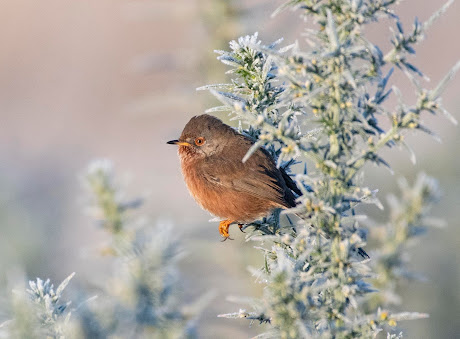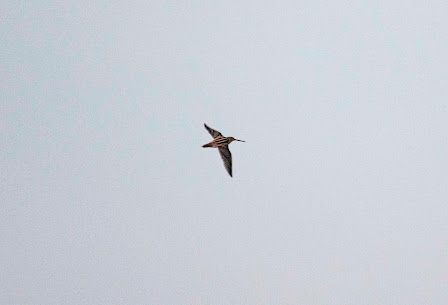A new year is upon us. The outlook for 2022 looks significantly brighter compared with this time last year, when we were locked down. South-west Surrey will again be my birding platform in the coming 12 months and, while I'll casually keep a local year list, I have a few other target-based plans as well. I've also moved house (more here) which has added a fun dimension to things.
 |
| Goosander were a theme locally in the first few days of 2022. |
Saturday 1st
2022 began with both the obligatory hangover and an early start at the Lammas Lands, where a male Tawny Owl was hooting to the south. Here I met Dave ahead of a morning of local birding and it got off to flier, too, with four Goosander – a drake and three redheads – heading high up the River Wey. My first along the river, Goosander is rare anywhere within a 5 km radius of Godalming.
Our Snipe stomp was pretty woeful – a measly three birds flushed. However, a first-winter Dartford Warbler was another pleasing record and presumably the bird I had on 20 November. Other bits from a decent, hour-long walk included a Little Egret in Hell Ditch, three Stonechats, two Kestrels and four Reed Buntings.
 |
| Dartford Warbler, Snipe and Stonechat. |
We then headed to Enton Lakes, where four drake Pochard – another Godalming area goodie – were present. Really unseasonal conditions meant plenty of birds were in song, but we didn't note much else here, save six Great Crested Grebes.
 |
| Pochard. |
We then headed a bit further afield, to Cutt Mill. Here, a redhead Goosander, seven Shoveler and 13 Mandarin were on the house pond, but better was to come along the track back up to the road: a female Lesser Spotted Woodpecker. A real bonus bird for New Year's Day, it stayed put for a while and allowed a small crowd of Goosander year list tickers to connect. Lovely stuff!
The morning ended with a nice bonus south-west Surrey year bird: Wigeon. Some 14 of them were on what was left of the Wrecclesham water meadow floods.
Sunday 2nd
Another unseasonably mild morning and another snipe stomp, this time at Shalford Water Meadows. Unlike the Lammas Lands there were decent numbers here: a very conservative minimum of 30 Common Snipe, plus two Jack Snipe which were flushed in close succession from virtually under my feet. A nice one to get – I'll return with the thermal imager. A surprise Woodcock completed the set nicely.
Other bits from a two-hour session included a drake Shoveler on Broadford Marsh, a pair of Stonechats at Bog Meadow, some Kestrel interaction on top of a nest box and six Cormorants.
 |
| Cormorants. |
I checked Snowdenham Mill Pond afterwards. To my delight, a group of six Goosander were present – a site first for me after years of expecting one here. The birds – two drakes and four redheads (two adult females and two first-winters) – showed fairly well, far more bothered with looking for food (including some 'scuba diving') than my presence.
 |
| Thorncombe Street Goosander ... at last! |
Incredibly enough this was a Thorncombe Street tick for me – and the first lifer for my old patch since the Red-throated Pipit in 2019! There have only been two previous TS area records and, while I don't visit the area too much anymore, I have kept tabs on this little waterbody, which is one of my favourite places. Amazingly it's the 12th duck species I've seen here. Also present were two Gadwall and three each of Teal and Mandarin, which concluded a pleasant few hours in the field.
 |
| Gadwall. |
Monday 3rd
It felt like early March up on The Hurtwood this morning, with plenty of birds in song and a Sparrowhawk pair engaged in full tumbling display. The highlight of the session was a group of at least 30 Bramblings on Breakneck Hill, feeding on fallen beechmast with 100 or more Chaffinches. Thirty may have been a serious undercount, too, as the birds were mobile and hard to follow, giving only the odd flash of a white rump or wheezy call.
 |
| Brambling. |
I speculated on 8 November on this blog that a Brambling flock may take up residence this winter, given the amount of beech in the area and following the bumper autumn for the species, so it was nice to see it had happened. Other bits included a Dartford Warbler calling in the usual area – marking the third year in a row this species has been logged here – a 10 or more Lesser Redpolls, three Bullfinches and a Raven.
Given the conditions I thought I'd try my luck at Unstead SF for some winter warblers. Loads of insects were on the wing near the works and lagoons and it was no surprise that a minimum of four Chiffchaffs were counted, including two in song. A very elusive Cetti's Warbler was skulking around between the two lagoons, two Reed Buntings were about and a male Stonechat was in Lagoon Field.
 |
| Blurry Cetti's Warbler. |
I popped out again at dusk, and had to wait half an hour after sunset before being graced by the presence of a local Barn Owl – always a magical species to encounter and an enigmatic, elusive bird locally. A Woodcock dropped into a nearby field to feed shortly afterwards as well.
Tuesday 4th
I was at Frensham Little Pond at first light, with one species on my mind: Bittern. After failing to see this species during my south-west Surrey big year in 2020, as well as last year (which was also the first time since 2002 none were reported at Frensham), I'm keen to connect this year. So, it was most welcome when Shaun P (Mr Frensham) messaged me yesterday saying he had one in flight. Sadly, today, I had no joy whatsoever, and had to settle for five Teal, six Pochard and two each of Water Rail and Kingfisher as consolation.
Wednesday 5th
I was back at Frensham Little Pond, where it was significantly colder pre-dawn with frost on the ground. Crucially I was armed with the thermal imager today. While picking up reedbed Bittern worked for me at the London Wetland Centre on 12 December, it was more of a struggle here with distance meaning it simply couldn't reach heat signals emitting from deep in the reeds.
However, I picked up a faint signal in the south-west reedbed and, upon switching to the bins, the outline of an essentially motionless Bittern could be made out, though it soon melted away. Pretty lucky to be honest, and a touch underwhelming, but pleasing nonetheless. I'll definitely be back – I'm keen to get good views this year, having not done so since 2016.
An impressive minimum of six Water Rails were vocalising pre-dawn and four drake Pochard were on the water, while a Raven flew over Tillhill Nurseries. A windswept Frensham Common was quiet. At the Great Pond, three Shoveler and a single female Pochard were noted, while two Firecrests were foraging successfully despite the cold in holly near the outlet stream.
 |
| Firecrest. |
Thursday 6th
No observations of note.
Friday 7th
I heard a Greenfinch singing from the kitchen window late morning and was struck by how less I hear this bird these days – it's declined so much since I was young. A look through my notes revealed I had only one double-figure count in 2021, and that included a family party ...
Saturday 8th
No birding today.
Sunday 9th
It was a cold, frosty and bright at Shackleford first thing, where 46 species were logged in an hour and a quarter. As they have been all winter, passerine numbers were relatively low, though they did include 60 Fieldfares, 25 Skylarks, four Stonechats and singles of Bullfinch and Reed Bunting. Lapwing, Kestrel and Ring-necked Parakeet were also of note, along with the wintering Little Grebe on Lydling Farm pond (where the Coot pair are already constructing a nest) and two Teal.
 |
| Kestrel, Lapwing and Pied Wagtail. |
A quick look at Loseley fields on the way home produced more than 120 geese, including 33 Greylags and eight Egyptian. Later on, a Red-legged Partridge ran over the road near Eashing.
Monday 10th
No observations of note.
Tuesday 11th
No birding today.
Wednesday 12th
An atmospheric mist was in the air this morning as I walked the Wey from Eashing to Godalming, logging 35 species. The best was a surprise Woodcock, flushed inadvertently from a ditch. I've now seen three locally this year – not bad given how elusive they are in the winter. Singles of Mandarin and Reed Bunting were also noted, 35 Siskins were near Westbrook and two Bullfinches included a singing male.
Thursday 13th
No birding today.
Friday 14th
A heavy frost coated the ground this morning and Snowdenham Mill Pond was partially frozen. A Kingfisher zipping over the south end was nice to see, while drake Gadwall and Mandarin were also noted, along with the Mute Swan pair.
I then checked out Eashing Fields, a newly created grassland area managed by Surrey Wildlife Trust on my (new) doorstep. What an introduction to this site, too – one of the first birds I picked up was a calling Dartford Warbler! It's always nice to bump into extralimital Dartfords and this one – an adult male – appeared quite happy in his little patch of gorse, though I've no doubt he was probably seething at the cold weather which likely moved him off a nearby heath. What a bird to have so close to home – and so soon after moving.
 |
| My second extralimital Dartford Warbler of 2022. |
Two Stonechats were also unexpected, along with a singing Skylark. Reed Bunting and a few winter thrushes rounded off an excellent debut session here that smacked of future promise.
Saturday 15th
 |
| Ring-necked Parakeet. |









1 comment:
What a pale looking Stonechat. I'm thinking its an effect of the camera rather than it being an Eastern possibility?
Post a Comment